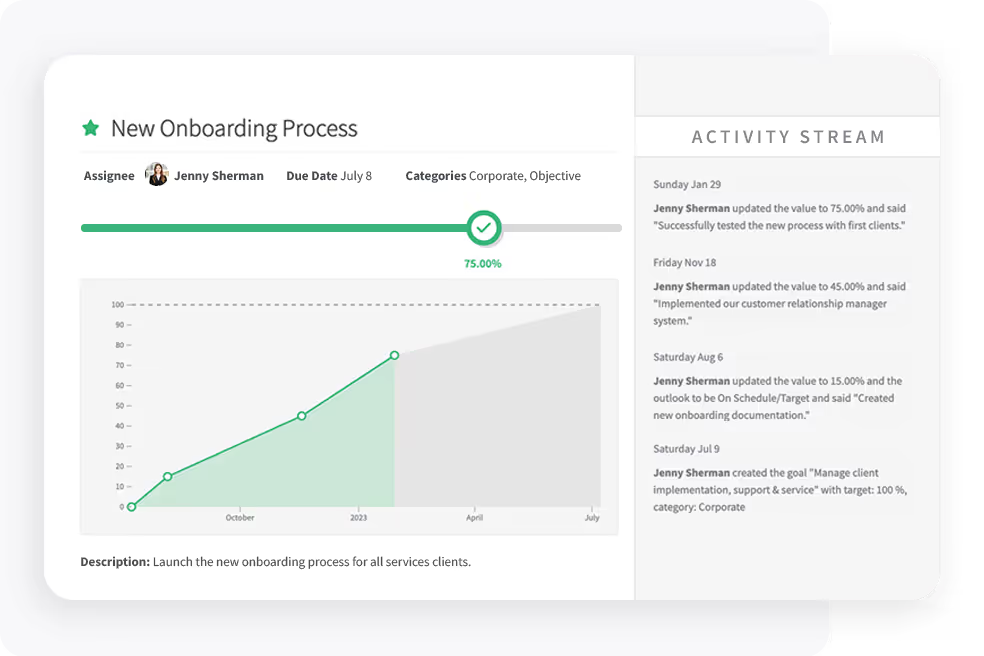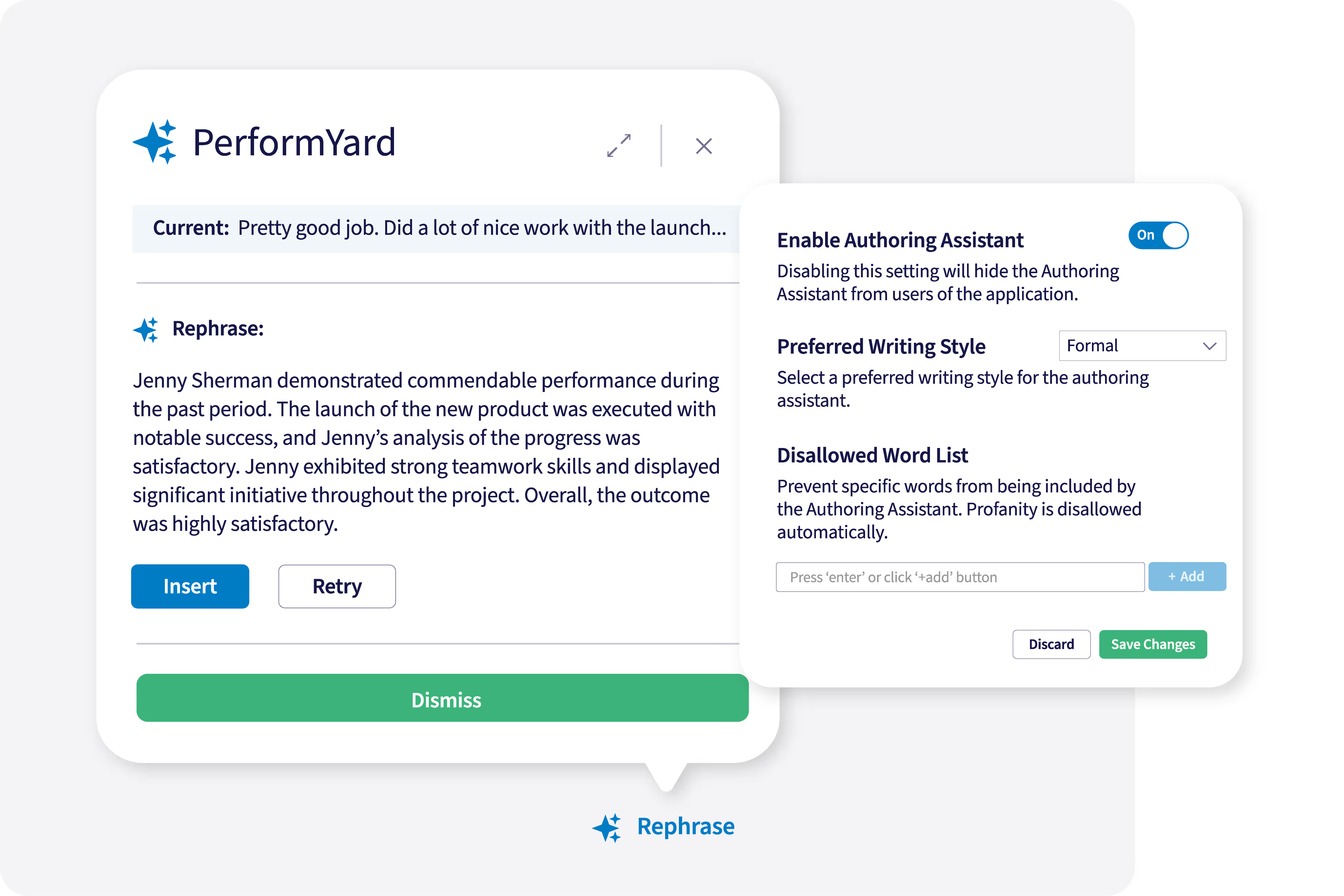How to (Safely) Use AI in Performance Management
Implementing AI in performance management can transform how we tackle evaluations and feedback. It’s especially useful for managers who have trouble synthesizing their thoughts. Generative AI provides us with a speedy way to support our employees to reach their personal and professional goals.
And employees agree. Over half of all workers in one Salesforce survey reported believing that generative AI will advance their careers. The trouble is, they don’t exactly know how. The same survey also found that 62% of respondents don't have the skills to use the technology effectively.
AI in performance management is a great way to introduce AI in your workplace. You can start helping managers use it in a professional capacity right now.
Here’s everything you need to know about how your HR department can empower managers to use AI in performance reviews.
AI in Performance Management – It’s Already Here
When talking about AI in performance management, generative AI, like ChatGPT, comes to mind—and not necessarily in a good way. No one wants to get a lifeless, critical review that was written by a robot.
Fortunately, that’s not the way AI is being used. Artificial intelligence programs function in so many more ways than simply generating text.
Even more importantly, AI isn’t poised to replace workers. It can’t replace human decision-making or critical thinking. It also can’t replace the collaborative relationships we build to get our best work done. Instead, it is meant to act like an assistant, helping you make your job and the jobs of others easier, as long as you know how.
How to Use Generative AI in Performance Management
With a little creativity, generative AI can take on a supportive role in performance management, enabling workers to save time, uncover interesting findings, and communicate more efficiently.
A few of the ways generative AI in performance management has been useful to HR and the teams they support include:
- Goal setting
- Generate high-level feedback and summarized feedback
- Career pathing
- Self-evaluation
- Clarification of thoughts and feedback
- Focus on relationships—not busywork
Goal setting
Setting goals is rarely a straightforward process. In addition to individual goals, managers have to think about larger, company-driven goals. It can be difficult to figure out who is best equipped to take on those goals.
Job descriptions (JDs) are a great place to start when you’re working with AI in your performance management process. Simply feed JDs into a generative AI program to get a list of potential goals for those particular job descriptions. Then, brainstorm which ones work, and which ones don’t, and modify them to fit your team. It can be a great way to get the juices flowing and ensure the right goals get paired with the right employees.

Generate high-level feedback and summarized feedback
Feedback rarely comes from a single brainstorming session. Managers are often compiling a list of little pieces of feedback here and there over days, weeks, months, and even years. Summarizing that information the old-fashioned way is a mammoth task, and important pieces of information are likely to fall through the cracks.
Manager notes can be entered into a GenAI program that can summarize them concisely and accurately. Then, managers can use the summary as a starting point to create feedback that contains valuable information for each employee.
Using AI in performance management also has the potential to create higher-level feedback. Not only can manager notes be entered, but programs can also analyze information from team members and customers on a wide variety of platforms to create a holistic view of employee performance.

Career pathing
Over three-quarters of employees are actively looking to expand their careers, but knowing exactly how to do that can be fuzzy. Breaking down a larger goal into smaller steps can help employees achieve their goals and advance their careers, but it can be a challenge, especially if there are possibilities they may not have considered.
Both managers and employees can input past progress as well as future aspirations into an AI program to create career pathing options. Based on that information, managers can create development guides for individual employees. They can also create more general guides for JDs that enable employees to see exactly what they need to do to expand into their existing roles and transition into new roles in the future.
Self-evaluation
It’s not just managers who can benefit from AI in performance management. Employees can use generative AI to work on a self-evaluation as part of a larger performance management process.
Before meeting with a manager, employees can enter notes they have taken about their performance into an AI program to create an overall summary. Different prompts can be used to gain new insights too. Employees could learn where to improve based on a set of numbers that are entered into an AI platform, or they could uncover strengths that they might not have identified without the ability for AI to accurately summarize a large set of data.
Clarification of thoughts and feedback
Preparing for performance reviews can be a daunting task, with the average manager spending 210 hours on reviews every year. Employees can spend a lot of time on their reviews too. It can be nerve-racking to be tasked with organizing their thoughts, identifying their achievements, and finding areas for improvement.
By utilizing AI in performance management, both managers and employees can feed their thoughts and performance review drafts into a generative AI platform to get feedback and edits. It can uncover a more professional way to phrase a thought, uncover key competencies, summarize goals, and create a new draft that can then be edited so that both managers and employees feel thoroughly prepared for their meeting.

Focus on relationships—not busywork
Conducting performance reviews can feel like a lot of busy work. Managers often feel like they spend the majority of their time filling out reviews rather than coaching and having conversations, which is what they want to do.
AI in performance management can be helpful because it can create a rough draft based on bulleted lists and spare notes. Managers can then zero in on their perspectives, think through their observations, and figure out how to communicate them instead of completing the mundane task of writing up the report. It frees up more time for managers to think about the important stuff, but it also means they get to have deeper, more meaningful conversations with their employees.
The Risks of Using AI in Performance Management
Much of the initial confusion and fear over AI has to do with a misunderstanding about what it does. It isn’t meant to create and replace human workers. Instead, it’s meant to generate data for a human worker to consider. It is especially important for human input to be present because there are risks that come with using AI in performance management including:
- Privacy
- Bias
- Inaccuracies
- Low-quality work
- Can build distrust
Privacy
GenAI, like ChatGPT, works been it’s given a lot of information. The problem is, that some of that information is sensitive. When running private information through a third-party generative AI program, there’s always the possibility that your information could be captured, stored, or hacked.
It’s very important to think carefully about what kind of information can and can’t be shared with AI programs. Creating guidelines can help ensure managers and employees don’t provide sensitive personal or company information when using a generative AI platform.
Bias
Because generative AI programs are created by people, they can be biased just like people. It can use overly blunt language and come up with inappropriate findings that can be downright offensive.
Anyone using AI in performance management must read through generated texts carefully. Remember that it is meant to be edited, so encourage managers and employees to modify texts according to their needs.
It also provides HR with an opportunity to train employees on how to use AI when it’s something they’re already motivated to learn. When everyone learns how to create more effective prompts, everyone is less likely to get biased content.
Inaccuracies
ChatGPT and other GenAI programs aren’t guaranteed to be accurate. Programs have been known to create hallucinations, which means the program incorrectly perceives patterns or the data is incorrectly decoded by the transformer, which results in inaccurate, nonexistent, or imperceptible output.
It is extremely important to aggressively check facts and any sources that are provided by AI. That includes factual knowledge that you can uncover by searching the internet, but it also includes making sure findings are based on accurate facts. For example, you don’t want to make a claim about performance that was based on an inaccurate finding by an AI program. It’s likely to upset your employees, which isn’t good for morale, productivity, or retention.
Low-quality work
GenAI programs, as they exist right now, don’t sound human. ChatGPT, in particular, has a unique tone that doesn’t come across as professional. It’s extremely inelegant and prone to re-summarizing the same information more than once. Not to mention, bias and errors can easily crop up in generated text.
It’s important to edit the work for bias and inaccuracies, as well as professionalism, so what you ultimately create is of the highest quality. That is especially true when it comes to AI in performance management, as job positions, incomes, and job security can all rely on the performance management process.
Can build distrust
People have some strong feelings about AI, and for the most part, they aren’t good. If workers know you’re using GenAI in the performance review process, they may inaccurately assume that it’s replacing human work. They aren’t likely to take it seriously, which means your entire performance management system becomes ineffective.
Make sure you communicate clearly about how you’re using AI in performance management. Demonstrate how it is being used to replace the busy work part of the process that takes up a lot of time so that reviews can focus on meaningful communication and collaboration. Show employees how any AI-generated text is edited, and give them a chance to play around with it as part of the review process. It will help them understand that it’s just another tool that can be used to make work easier.
HR Needs to Develop Guidance Around Using AI in Performance Management
Whether we like it or not, AI is here, and it’s here to stay. HR, managers, and employees can learn how to use these programs to reduce busy work, free up more time for mentorship, and gain support to accomplish personal and company-wide goals. But it’s not without its challenges.
HR needs to create a system for AI in performance management by teaching everyone when it’s appropriate to be used, how to use it without fear of privacy concerns, and how to prompt it the right way, with updates in training as the technology evolves. When you do, you’ll empower workers to use AI in performance management safely and accurately to the benefit of all of your employees, managers, and the company as a whole.


.jpg)

.jpg)
